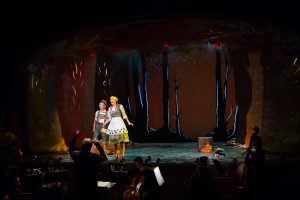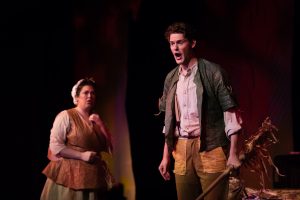
By Dennis D. Rooney
Those of us who as children read the Grimm Fairy Tales, or better yet, had them read to us, know all about creepy castles, evil forests, wicked stepmothers, wily foxes and sanguinary wolves, ungrateful kings, scheming dwarfs, and other bad actors we came to know from the folk tales collected by Jakob and Wilhelm Grimm in the early 19th century.
There was nothing remotely warm or fuzzy in them.
By 1891, however, when Engelbert Humperdinck was asked by his youngest sister, Adelheide Wette, to set four songs she had adapted from Grimm to accompany a home puppet show staged by his nieces for Christmas, he became sufficiently enthused to compose a three-act opera on the tale of Hänsel and Gretel. Its premiere in Weimar just before Christmas of 1893, conducted by Humperdinck’s friend, Richard Strauss, was a huge success.
In keeping with the demands of bourgeois gentility, the gruesome aspects of the original story were softened: The wicked stepmother became a put-upon mother hard pressed to feed her family; the drunken father became a jovial, hard-working fellow who occasionally got a bit tipsy; and the Gingerbread Witch became less horrifying and more a figure of fun.
Humperdinck (1854-1921), who had assisted Richard Wagner in the premiere of Parsifal and also tutored the composer’s son, Siegfried, clothed his “Fairy-Tale Opera” in distinctly Wagnerian raiments, enabling him to suggest the story’s more sinister elements in a colorful score that employs motives, chief among which is that of the “Evening Prayer,” heard in the horns at the beginning of the Prelude to Act One.
For the Dec. 6 performance of Hansel and Gretel (sung in English) by Palm Beach Opera at the Crest Theatre in Delray Beach, the first few rows of seats on the main floor had been removed to accommodate the 12 instruments (eight strings, flute, clarinet, two horns) and piano that accompanied the singers. Despite the experienced freelance players and conductor David Stern, the sonority heard in the Prelude, Witch-Ride and Dream Pantomime was distressingly threadbare.
The singers were drawn from the Palm Beach Opera’s Benenson Young Artist and Bailey Apprentice Artist programs. The best voice belonged to bass-baritone Ted Allen Pickell (Father). Soprano Maria Vasilevskaya (Hansel) and mezzo-soprano Patricia Westley (Gretel) were well matched vocally and sang their many thirds in duet most fluently, although one noticed with concern a tremolo in the former’s voice, an unfortunate fault in such a young singer.
Mezzo-soprano Cara Collins (Mother/Witch) brought vocal strength and experience to her performance. Sopranos Emily Blair and Emily Helenbrook were creditable as the Sandman and Dew Fairy, respectively. The small children’s chorus at the opera’s end was drawn from Young Singers of the Palm Beaches.
American singers are known for their lack of success in singing their native tongue intelligibly, and the presence of a diction coach on the roster did nothing to change that. Supertitles displayed on monitors flanking the proscenium made it easier for the majority of the audience to understand their words.

The projection, however, had some problems, especially during Act I. Spellcheck is undoubtedly to blame for a choice howler, when the Mother sings, “I can’t bear it” but was “I can’t bare it” on the display.
The paper sets and costumes, and the projections and lighting, were striking solutions to the Crest’s cramped stage and primitive lighting. Director Fenlon Lamb and her colleagues all deserve credit for creating strength from adversity.